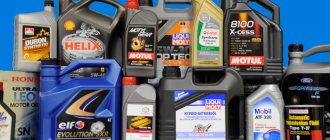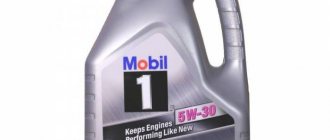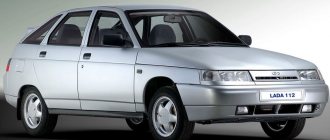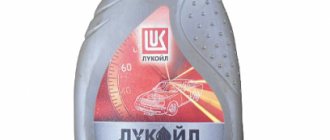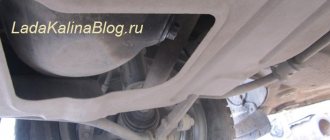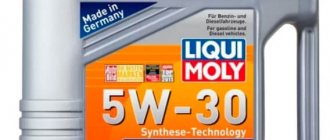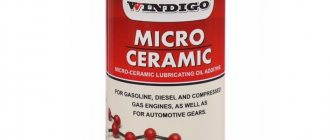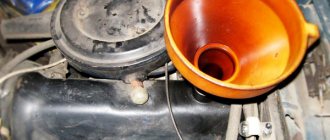There are products on the Russian automobile oil market that Russian car owners have mixed opinions about. One of these is Mitsubishi motor oil, intended for use in cars of this Japanese manufacturer. And since we have quite a lot of followers of this brand, scammers began to produce counterfeit goods. Naturally, such a fake cannot be compared with original oils in terms of its quality characteristics. This is the reason for the negative feedback.
Who produces the original lubricant
Mitsubishi does not produce motor oil for its cars, although its engineering and scientific personnel are actively involved in its development. The work is being carried out jointly with specialists from Nippon Oil & Energy, a subsidiary of the largest Japanese corporation. It also includes the Mitsubishi Oil division created by Mitsubishi. Nippon specializes in oil production and the production of automotive lubricants based on it, and has its own brand of motor oil, known throughout the world - Eneos.
Japanese engines from major Japanese automakers, including Mitsubishi, have unique design features. Therefore, special oil formulations are produced for them - specifically for each car manufacturer. Honda, Toyota, Subaru are also included in this list, having their own original oils. For them, these products, Nippon feed, are also produced by Idemitsu Corporation.
Japanese power units are designed for low-viscosity oil fluids - 0W20, 5W20, 0W30, 5W30, 10W30, as well as 5W40. Their main high-temperature quality indicators correspond to viscosity 20 and 30, with the exception of low-temperature (winter) viscosity. Here you can purchase lubricant both for the northern regions of the Russian Federation (0W), which can easily ensure engine crankability down to -30°C, and for moderate latitudes (10W), up to a temperature limit of -20°C. Synthetic and semi-synthetic motor fluid is produced for consumers.
Mitsubishi Lancer 6(CB,CD) 1991-1995
The recommended engine oil for Mitsubishi Lancer is selected depending on the engine type.
Gasoline power units
1994 model
For 4G92, 4G93, 4G13 Mitsubishi Lancer engines, the car manufacturer recommends using SG class oils according to the API system. The viscosity of the lubricant is determined according to scheme 1, taking into account the temperature of the region in which the car will be operated.
Scheme 1. Dependence of lubricant viscosity on ambient temperature.
According to Scheme 1, it is necessary to use the following lubricants:
- at temperatures below -300C, fill in SAE 5w-20 motor oils;
- if the temperature is less than +100C use SAE 5w-30;
- at temperatures below +200C pour 5w-40, 5w-50;
- in temperature conditions from -300C to +400C, fill in 10w-30;
- if the thermometer reading is above -300C, use 10w-40, 10w-50;
- if the temperature is above -150C, use 15w-40, 15w-50;
- If the air temperature is more than -100C, pour 20w-40, 20w-50.
The Mitsubishi Lancer operating instructions indicate the following volumes of engine oil required when replacing:
- 3.8 l for engines 4G92, 4G93;
- 3.3 l if engines are 4G
Diesel car engines
According to the Mitsubishi Lancer manufacturer's manual, for 4D68 engines it is recommended to use the oil type CD (or higher) according to the API system. It is necessary to select the viscosity of the motor oil according to scheme 2.
Scheme 2. Dependence of oil viscosity parameters on ambient temperature.
According to scheme 2, it is recommended to use motor oils:
- SAE 30 if the temperature range is from 00C to +400C;
- 20w-40 when the thermometer is more than -100C;
- 15w-40 if the temperature is greater than -150C;
- 10w-30 at temperature conditions -200С to +400С;
- 5w-40 if the thermometer reading is less than +200C;
- 5w-30, 5w-50 at a temperature less than +100C.
The volume of engine oil required when changing for the 4D68 engine is 5.1 liters.
Mitsubishi oil production technology
Japanese oil refining giants produce base oil (MM or lubricant) for automotive lubricants from crude oil that they themselves produce. Moreover, the raw materials cost them almost nothing. During primary processing, oil is divided into light and heavy fractions. From the lungs, this is, for example, associated gases - ethylene, gasoline. Heavier light fractions - kerosene, diesel fuel.
The heaviest components are gas oil and tar. A hundred years ago, these fractions were burned - until humanity learned to make lubricants from them. Now tar and gas oil undergo distillation and thorough purification, processed using hydrotreating and deep catalytic hydrocracking technologies. The result is a colorless liquid, devoid of harmful impurities - such as water, mineral salts, aromatic hydrocarbons, sulfur and phosphorus compounds, paraffins, and other components. Its quality characteristics are very close to those of real 100% synthetics.
The base oil is fully compatible with any additives and is neutral with respect to seal materials - oil seals, gaskets. Mixes well with mineral oils, forming semi-synthetic products.
Motor oil for Mitsubishi is HC or VHVI synthetic. True, not everyone considers hydrocracking oils synthetic. Some companies even went to court over this issue. Manufacturers of PAO-synthetic oils stubbornly refuse to recognize them, considering them semi-synthetic or completely mineral. The most interesting thing is that this assessment is also fair. However, it concerns only the origin, but not the quality indicators of this base oil.
Alternative options
An analysis made on the basis of reviews from users and vehicle maintenance specialists makes it possible to come to the conclusion: the products of the following brands are worthy of the attention of Mitsubishi car owners.
These are just some of the possible options. The list could be significantly expanded, but a simple listing of companies that produce high-quality lubricants is not of fundamental importance. In any case, you need to be guided by three important rules.
Remember the elementary truth: saving on the purchase of motor oil inevitably results in an increase in engine repair costs. Take good care of your Mitsubishi!
Source
Main oil components
As can be seen from the diagrams, almost all lubricants for automobile engines consist of 3 main components:
- The base is mineral, semi-synthetic or synthetic.
- A viscosity modifier that increases the stability of viscosity properties in the operating temperature range.
- A package of additives that improves the properties of the base lubricant.
The additive package has a diverse purpose:
- Detergent - has washing properties and also prevents oxidation reactions, neutralizing acids with a large amount of alkali, which is in its composition. It washes away soot, slag, varnish and other high-temperature deposits well.
- Dispersant - does not allow small particles of sediment to precipitate back onto the surface of parts. They are suspended within the oily liquid. Many motorists have noticed that used grease has a dark, almost black color. This indicates that the engine is well cleaned and the dispersant is doing its job conscientiously.
- Anti-wear additives - prevent premature aging of the engine, protecting its parts from wear. Help increase its resource. Protect metal surfaces where a protective oil film cannot. These additives are adsorbed directly into the metal, changing its crystal structure, making it slippery. Thus, abrasive wear no longer occurs.
- Antioxidants – prevent oil aging. During operation, the oil composition is exposed to oxygen, nitrogen oxides and other reagents at high temperatures that accelerate chemical reactions. The lubricant inevitably oxidizes. Its additives gradually break down, forming sediments that promote corrosion of metals. Antioxidants come in two types: oxidation inhibitors and thermo-oxidative additives. Inhibitors work directly in an oily liquid environment, and thermal oxidative inhibitors work on metal surfaces.
In addition to the main ones, developers of new oils constantly introduce additional components. The content depends on how the engines of each manufacturer, including Mitsubishi, behave during testing.
Assortment of oils for Mitsubishi cars
Oil for Mitsubishi has a base base obtained by hydrocracking. But there are also Full Synthetic and semi-synthetic class products. Recommended for use in models such as Pajero of all modifications, Outlander, Lancer, ASX, Grandis, Colt and others.
Semi-synthetics
- Genuine Oil SAE 5w30 is a very high quality oil mixture. 70% of the base composition is reserved for mineral NS-synthetics, the remaining 30% is a completely synthetic composition. Until recently, it was produced in a universal modification with specifications from API - SM/CF, as well as ILSAC - GF. Since 2015, Nippon has improved the quality of the lubricant. It now complies with the highest classes of both standards – SN and GF5. In terms of price-quality ratio, this mixture is optimal for car owners. The original oil is sold under the numbers MZ320363, MZ320757, MZ320756. For compatibility with modern exhaust gas treatment systems, the lubricant has a low phosphorus content. Can be applied to gasoline engines produced since 2004, as well as to diesel engines produced in 1990. Adapted to diesel fuel, which contains a large amount of sulfur.
- DiaQueen SL Super 10W30 - this lubricant is designed on a base obtained using hydrocracking technology. It can be classified as both semi-synthetic and synthetic oils - as you like. The mixture is all-season, intended only for gasoline engines. Therefore, the American API classifier assigned it the SL category. It can be poured inside power units with a GDI injection system, turbocharged and naturally aspirated. It has a powerful package of detergent and antioxidant additives. Due to this, it is used with increased intervals between replacements.
Synthetic compounds
- Engine Oil Fully Synthetic SAE 5W-40 SM/CF is a universal motor mixture, the base composition of which is 100% synthetic. The name indicates the classes that the American API standard assigned to it. It has all the best qualities inherent in 100% synthetic compounds. The interval between replacements, compared to NS synthetics, is longer. Prevents premature wear of engine parts, eliminates noise and vibration.
- DiaQueen Motor Oil SAE 0W20, 5W20, 5W30 SN/GF5 - this series of synthetic motor oils is very popular. Previously, these lubricants were also produced with a lower specification - SL/GF C 2015, their quality composition was improved and received the highest rating from API and ILSAC. Recommended by the automaker for new engines of the latest modifications. The universal lubricant is fully compatible with all modern exhaust gas aftertreatment systems. Can be used in multi-valve and turbocharged engines with direct injection. Belongs to the group of energy-saving oils.
- Engine Oil 0W20 SM - the base base of this product is made by catalytic hydrocracking. The oil mixture has a good viscosity index of 175, ensuring stable viscosity characteristics over the entire operating temperature range. It has a pour point of -36°C. That is, it actually services engines down to temperatures as low as -30 degrees. Has low volatility. The proportion of sulfur does not exceed 0.2%.
Mitsubishi Lancer X engine oil
For all Lancer X gasoline engines, Mitsubishi recommends using oils: – API quality level not lower than API SM. Or more modern SN, SP. – ACEA quality level A1/B1, A3/B3, A3/B4, A5/B5. – Quality level according to ILSAC GF-3 or GF-4. Both have become obsolete and have been replaced by the GF-5, and are now in the process of being replaced by the ILSAC GF-6A. (info for 2021.)
Surely many will not understand anything from this mass of letters and numbers, and in fact, for a specialist, this translates as: “Use motor oil. Any."
For those who do not understand , I recommend considering only three specifications from this list:
- ILSAC GF-5 (GF-6A) - oils primarily aimed at achieving fuel efficiency. With frequent replacement intervals, they cope with their functions without any problems. Thanks to the presence of special additives in ILSAC oils, it is with them that, most often, the engine runs quieter. Viscosity 0W-20, 5W-20, 0W-30, 5W-30, 10W-30.
- ACEA A5/B5 – in comparison with the 1st, provides fuel economy due to reduced operating viscosity. Good cleaning properties. Viscosity 5W-30, 5W-20, 0W-30, 10W-30. I think it's the best choice.
- ACEA A3/B4 – provides the highest level of protection under high loads, has the greatest cleaning properties among the oils approved for use. Viscosity from 0W-30 to 10W-60.
The viscosity of the engine oil should be selected based on climatic and operating conditions. For most regions of Russia, these are oils with a viscosity of 5W-30. For regions with harsh winters, it is more advisable to use 0W-*0 oils for better protection when starting the engine in severe frosts.
For all gasoline engines with a volume of 1.5 to 2.0 liters, a little more than 4 liters of oil is required (4.2 - 4.3 liters). Suitable oils can be selected in the store.
For a 2.0 liter engine with a power of 241 l/s of the Ralliart version, 5.1 - 5.3 liters of engine oil will be required.
For trouble-free operation of the car, the engine oil change interval should not exceed 10,000 km or once a year.
